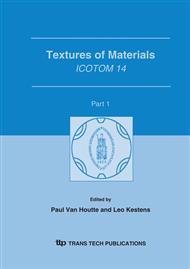[1]
T. Watanabe: Res. Mechanica, Vol. 11 (1984), pp.47-84.
Google Scholar
[2]
J. L. Walter, J. H. Westbrook and D. A. Woodord: Grain Boundaries in Engineering Materials (Metallurgical Society of AIME, 1974).
Google Scholar
[3]
Grain Boundary Structure and Kinetics, Materials Science Seminar, Milwakee (ASTM, 1979).
Google Scholar
[4]
G. Palumbo, E. M. Lehockey and P. Lin: JOM, Vol. 50, Num. 2 (1998), pp.40-43.
Google Scholar
[5]
E. M. Lehockey and G. Palumbo: Materials Science and Engineering, A237 (1997), pp.168-172.
Google Scholar
[6]
G. Palumbo and K. T. Aust: Acta Metallurgica et Materiallia, Vol. 38, Num. 11 (1990), pp.2343-2352.
Google Scholar
[7]
D. C. Crawford and G. Palumbo: Metallurgical Transactions A, Vol. 23A (1992), pp.1195-1206.
Google Scholar
[8]
P. Lin, G. Palumbo, U. Erb and K. T. Aust: Scripta Metallurgica et Materialia, Vol. 33, Num. 9 (1995), pp.1387-1392.
DOI: 10.1016/0956-716x(95)00420-z
Google Scholar
[9]
C. Cheung, U. Erb and G. Palumbo: Materials Science and Engineering A, Vol. A185 (1994), pp.39-43.
Google Scholar
[10]
T. Watanabe and S. Tsurekawa: Acta Materialia, Vol. 47, Num. 15 (1999), pp.4171-4185.
Google Scholar
[11]
E. M. Lehockey, G. Palumbo and P. Lin: Scripta Materialia, Vol. 39, Num. 3 (1998), pp.353-358.
Google Scholar
[12]
D. G. Brandon: Acta Metallurgica, Vol. 14 (1966), pp.1479-1484.
Google Scholar
[13]
G. Palumbo, K. T. Aust , E. M. Lehockey, U. Erb and P. Lin: Scripta Materialia, Vol. 38, Num. 11 (1998), pp.1685-1690.
DOI: 10.1016/s1359-6462(98)00077-3
Google Scholar
[14]
R. C. Pond and D. A. Smith: Philosophical Magazine, Vol. 36, Num. 2 (1977), pp.353-366.
Google Scholar
[15]
H. Kokawa, T. Watanabe and e S. Karashima: Journal of Materials Science, Vol. 18 (1983), pp.1183-1194.
Google Scholar
[16]
C. B. Thomson and V. Randle: Acta Materialia, Vol. 47, Num. 12 (1997), pp.4203-4209.
Google Scholar
[17]
V. Randle: Acta Materialia, Vol. 47, Num. 15 (1999), pp.4187-4196.
Google Scholar
[18]
R. L. Fullman and J. C. Fisher: Journal of Applied Physics, Vol. 22, Num. 11 (1951), pp.1350-1355.
Google Scholar
[19]
C. B. Thomson and V. Randle: Acta Materialia, Vol. 45, Num. 12 (1997), pp.4909-4916.
Google Scholar
[20]
M. Kumar, A. J. Schwartz and W. E. King: Acta Materialia, Vol. 50 (2002), pp.2599-2612.
Google Scholar
[21]
P. Lin G. Palumbo and K. T. Aust: Scripta Materialia, Vol. 36, Num. 10 (1997), pp.1145-1149.
Google Scholar


